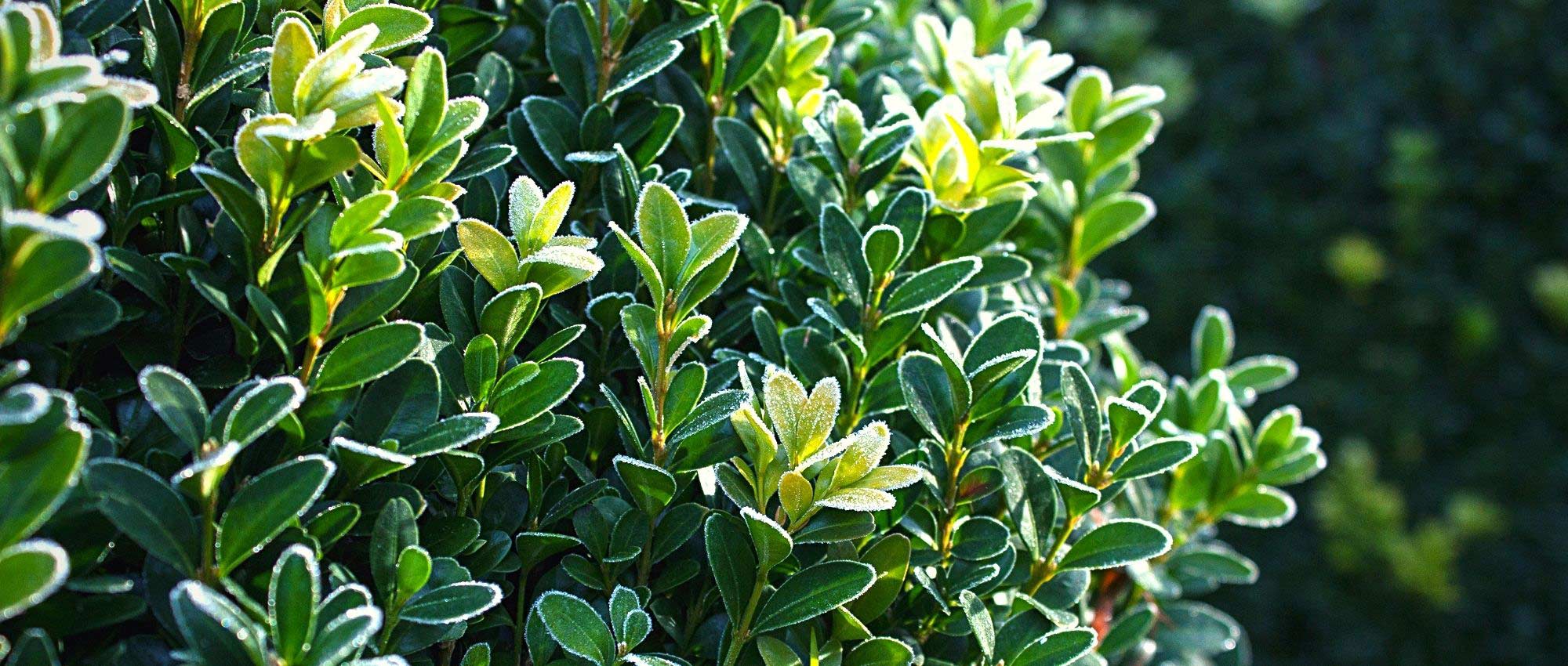
10 hardy evergreen shrubs
Our selection of frost-hardy shrubs!
Contents
Evergreen bushes have the advantage of remaining decorative all year round. They are perfect for creating a hedge that provides privacy even in winter. Some stand out for their excellent hardiness, which allows them to be grown even in a cool climate or in mountainous areas. They can therefore be planted in most regions of France. Discover our selection of evergreen bushes that best withstand cold, as well as our tips to grow them!
And if you want more choice, don’t hesitate to consult our full range of hardy evergreen bushes!
Cotoneaster
Cotoneaster is a bush that bears small leathery, dark green leaves and very decorative bright red berries. It has a broad, spreading habit, and some species layer naturally. Ideal bush for covering a slope! Cotoneaster flowers in spring and then bears numerous white or pink flowers. Flowers are single, five-petalled, and are scented and melliferous, favoured by pollinating insects. Berries generally appear in September–October. They are usually bright red and very decorative. In some varieties, they can be orange or black. They are not edible for humans but are enjoyed by birds. Cotoneaster is an undemanding bush, easy to grow. It likes well-draining soils and adapts to different exposures, tolerating sun as well as shade. As to hardiness, it can withstand down to −25 °C. We particularly recommend Cotoneaster franchetii and Cotoneaster dammerii, which adopt a creeping habit and are ideal for slopes, as well as Cotoneaster lacteus, better grown as a hedge. There are also deciduous species.
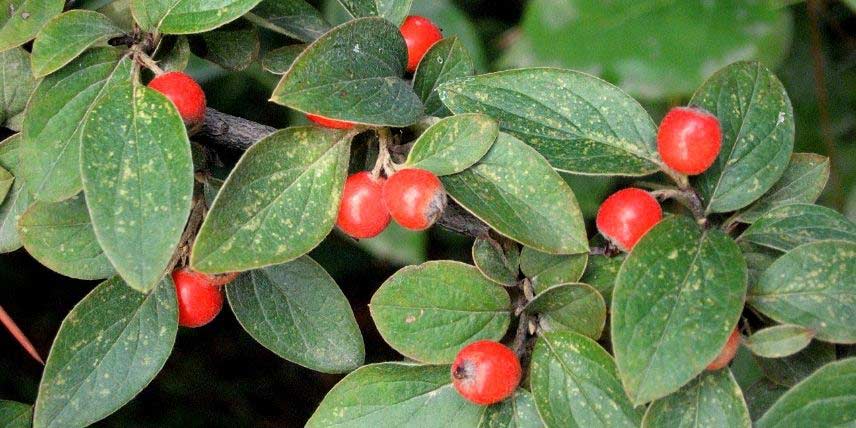
Small leaves and bright red berries of Cotoneaster franchetii (photo A. Barra)
Read also
Be attentive to evergreen bushesPyracantha
Pyracantha, also known as firethorn, is a bush often used as a defensive hedge, as its branches bear sharp thorns. It thus creates an impenetrable barrier. It produces a profusion of small melliferous white flowers in late spring, but is mainly valued for its colourful berries that appear in autumn. Depending on variety, they can be red, orange or yellow. They are enjoyed by birds. Pyracantha is an easy-to-grow bush, very adaptable and fast-growing (up to 50 cm per year). Ordinary soils, even poor and dry ones, suit it very well. Besides being very hardy, it is also resistant to drought, pollution, wind… Regarding hardiness, it tolerates between −17 and −20 °C.
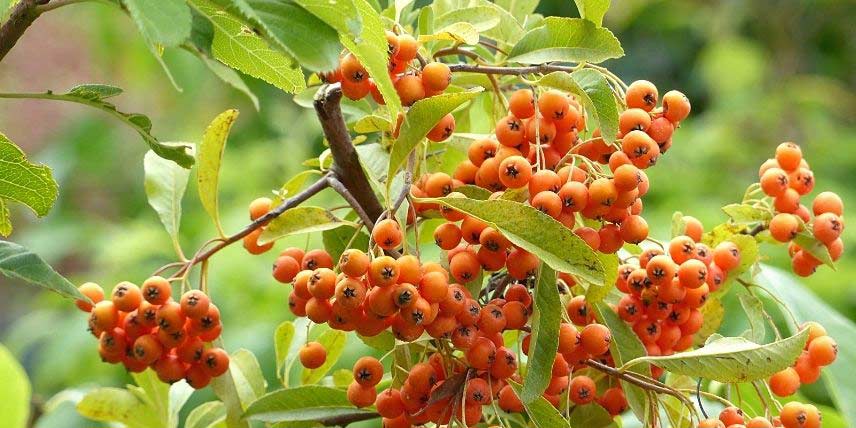
Pyracantha ‘Golden Charmer’ produces highly decorative orange berries in autumn
Discover other Evergreen shrubs
View all →Available in 0 sizes
Available in 1 sizes
Available in 1 sizes
Available in 1 sizes
Available in 1 sizes
Available in 1 sizes
Available in 1 sizes
Available in 1 sizes
Available in 2 sizes
Available in 1 sizes
Mahonia
Mahonia is a bush that bears beautiful, deeply divided, dark green, glossy foliage. Some varieties are notable for the fineness of their foliage, such as Mahonia ‘Soft Caress’, whose narrow leaflets recall fern fronds. Mahonia is in any case a bush valued for its graphic appearance. Moreover, it offers very bright yellow flowering, which takes place in autumn, winter or early spring, depending on variety. It then bears terminal clusters of numerous rounded, melliferous flowers. Its decorative, deep-blue berries are also appreciated in spring. Mahonia is a bush that thrives in shade, in well-draining soil. We recommend choosing its position carefully, as it does not like being moved. It dislikes excess moisture, and heavy soils may asphyxiate its roots. However, it can be planted in poor soil and proves fairly drought-resistant. Mature specimens tolerate temperatures down to around −20 °C. It is equally at home in a border, as a specimen or integrated into a hedge, and can also be grown in a large container. Mahonia is a bush that requires very little maintenance. We nevertheless recommend pruning once flowering has finished.
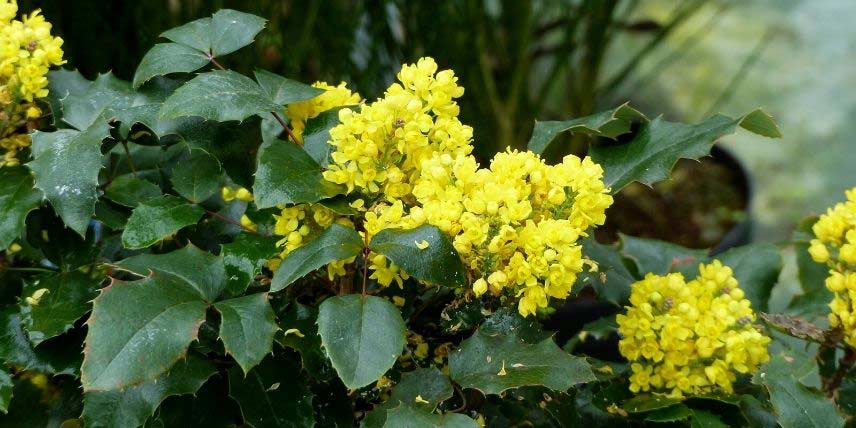
Yellow flowers of holly-leaved mahonia, Mahonia aquifolium
Box, Buxus sempervirens
Boxwood is an evergreen bush bearing attractive small, dark green, leathery, ovate and aromatic leaves, paler on the underside. It produces small creamy-white flowers in spring (April–May), much visited by bees. Boxwood is often used to form hedges or topiary, particularly in French-style gardens. It is a bush that easily gives structure to the garden and can, for example, be used to create edging to define perennial or vegetable beds. Although it grows very slowly, it is long-lived. Boxwood prefers partial shade and well-draining soil rich in humus and slightly calcareous, but it is very accommodating and adapts to a range of situations. When planted in a damp, shaded spot it grows larger and produces darker leaves, whereas in a warm, dry position it adopts a more compact habit and produces paler-coloured leaves. Once established, it tolerates heat and drought without difficulty. We recommend pruning once a year, in June.
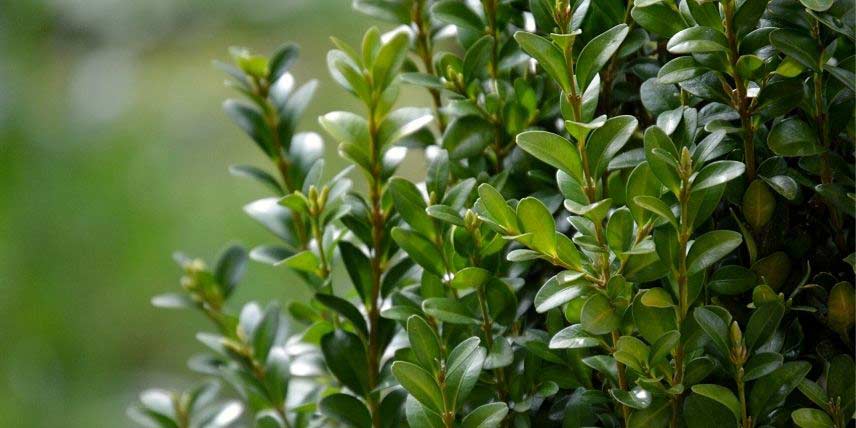
Small green leaves of boxwood, Buxus sempervirens
⇒ Boxwood: planting, pruning, care
Aucuba japonica
Aucuba japonica is a bush that bears large variegated, thick and glossy leaves. They are dark green and appear splashed with numerous yellow spots! At maturity, it will not exceed 3 metres in height with a 2-metre spread. Its foliage is particularly dense and highly effective at screening. Its spring flowering is fairly discreet, in the form of small pink four-petalled flowers, grouped in clusters. They are followed, on female plants, by bright red ovoid berries that persist throughout winter. Aucuba japonica thrives in shade. Very adaptable, it tolerates pollution and drought, and shows little susceptibility to disease… It is a low-maintenance bush, ideal for poor soils and spots difficult to plant! Also perfect for city gardens. As for its hardiness, it tolerates down to -15 °C. There is also a variety with plain green, non-variegated leaves: Aucuba japonica ‘Rozannie’.
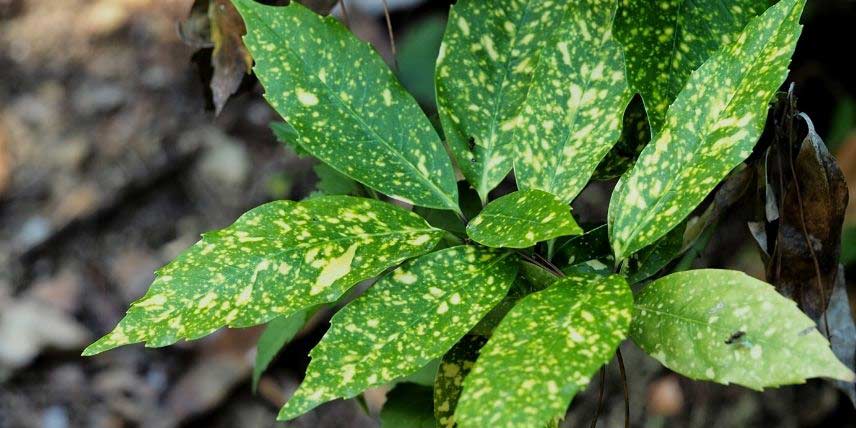
Aucuba japonica bears yellow-variegated foliage, very striking
Skimmia
Skimmia japonica is a bush that grows naturally in the understorey of Japan and China and that produces dense foliage made up of large, thick dark green leaves. It belongs to the same family as citrus trees such as lemon and orange trees! It produces in spring a beautiful display of terminal panicles, fairly dense, composed of small white, pink or purple flowers. Some varieties are very fragrant! This is the case for example with ‘Fragrant Cloud’. Skimmia is a dioecious bush: there are male and female young plants. The latter, if planted near a male young plant, produce red berries that remain decorative throughout the winter. In our climate, Skimmia does not exceed 1.50 m in height, and it grows fairly slowly. However, it is an almost foolproof bush! It tolerates pollution, wind and poor soils… It nevertheless prefers rich, cool, rather acidic soils. It is perfect in a heather soil bed, alongside azaleas and camellias.
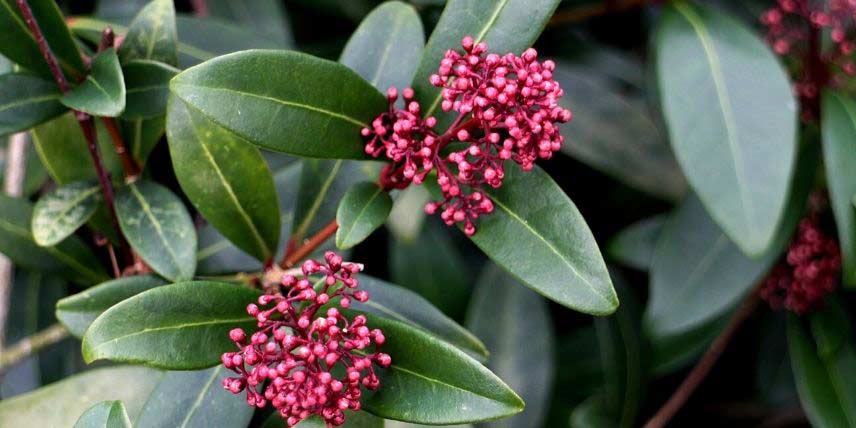
The purplish-pink flower buds of Skimmia japonica ‘Rubella’ stand out nicely against its dark green foliage (photo Dominicus Johannes Bergsma)
Pieris japonica
Japanese andromeda is a heather-soil bush prized for its decorative foliage, and especially for its young shoots, which have a lovely bright red colour! In spring, between March and May, it produces an impressive display of panicles bearing numerous small white or pink bell-shaped flowers. The flowering is particularly striking in the variety Pieris japonica ‘Debutante’, which is covered in a multitude of white flowers in spring! Pieris can reach up to 4 metres in height at ripeness, but there are also compact varieties that adapt very well to growing in pots (‘Little Heath’, for example, does not exceed 60 cm in height!). It is an easy-to-grow bush that prefers partial shade and slightly acidic soils. We recommend pairing it with other heather-soil bushes such as rhododendrons, Skimmia, Kalmia and camellias.
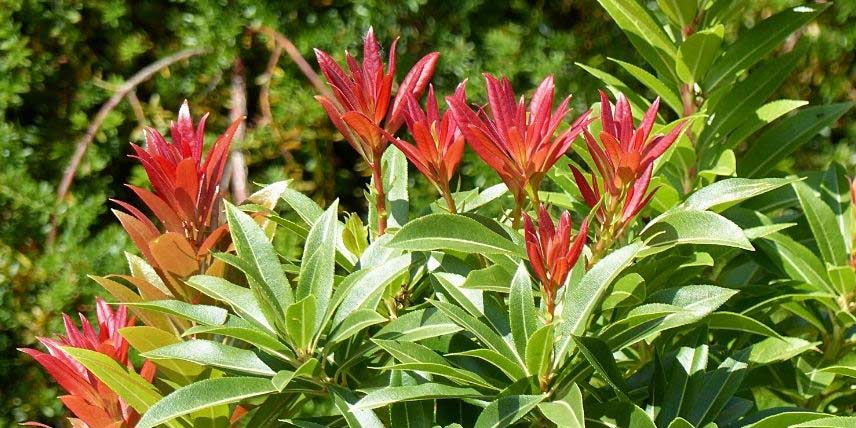
Young bright red leaves of Pieris formosa ‘Wakehurst’
Holly, Ilex aquifolium
Holly is a bush that bears very beautiful, dark green, glossy leaves, thorny on the edge of the lamina. Leaves generally remain on the bush for three years and are renewed gradually. There are variegated varieties: for example Ilex aquifolium ‘Silver Queen’ or ‘Argenteomarginata’… Holly produces small, rather inconspicuous white flowers in spring. The common holly, Ilex aquifolium, is generally dioecious: there are male and female young plants, so several young plants must be planted for fruit to set (although self-fertile varieties exist, such as Ilex aquifolium ‘Pyramidalis’). It is then the female plants that bear bright red, spherical drupes, which remain decorative throughout winter. They are eaten by some birds, such as blackbirds and thrushes. Holly grows slowly but is very long-lived, as it can live for more than 300 years! It is hardy, thrives in shade or partial shade, in deep, cool, humus-rich soil that is rather acidic and free of lime. However, variegated varieties can easily be planted in full sun. It is an ideal bush for understorey or as a hedge, whether allowed to grow freely or clipped. It can also be clipped to form topiary. Perfectly hardy, it tolerates between -15 and -20 °C.
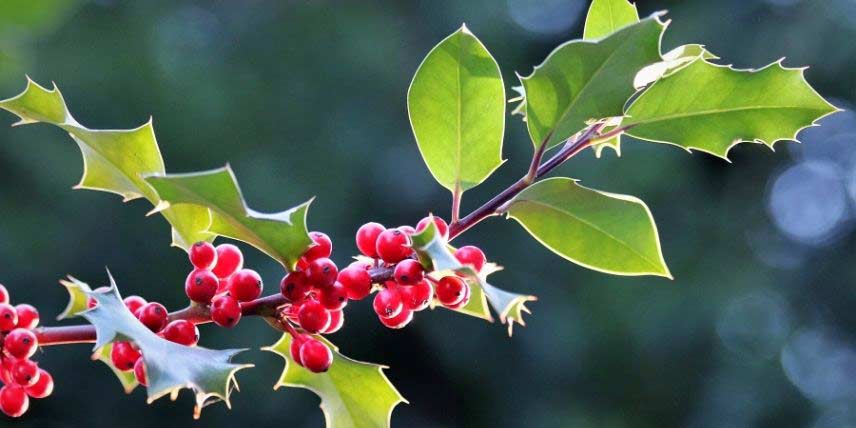
Red fruits and thorny leaves of holly, Ilex aquifolium
Euonymus fortunei
Spindle Euonymus fortunei is a beautiful evergreen bush, which, depending on variety, can take a bushy, creeping or even climbing habit. It bears entire, ovate leaves and is available in many varieties variegated with white or yellow. We particularly recommend variety ‘Emerald’n Gold’, which offers beautiful golden foliage. Euonymus fortunei produces a discreet spring flowering, consisting of small white four-petalled flowers. In autumn, it bears capsules enjoyed by birds. Bushy varieties are perfect for forming a hedge. Euonymus fortunei can tolerate between –15 and –20 °C.
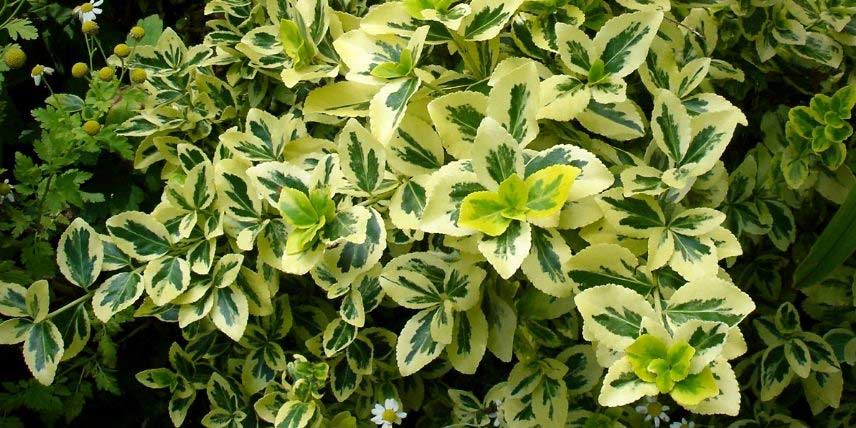
Variegated foliage of spindle Euonymus fortunei
Kalmia latifolia
Kalmia latifolia, also called mountain laurel, is a bush native to North America that offers very beautiful tender pink flowering. It flowers in spring, in May–June, and even before opening the flower buds are already very decorative! Flowers are numerous and delicate, shaped like small flared cups. Kalmia latifolia grows slowly and reaches 2 to 3 metres at ripeness. It is very hardy, as it tolerates down to −30 °C. Place it nevertheless in a spot sheltered from cold winds. It is a heather soil bush, which likes rather acidic, cool soil in partial shade. You can associate it with rhododendrons, hydrangeas, Pieris japonica and camellias.
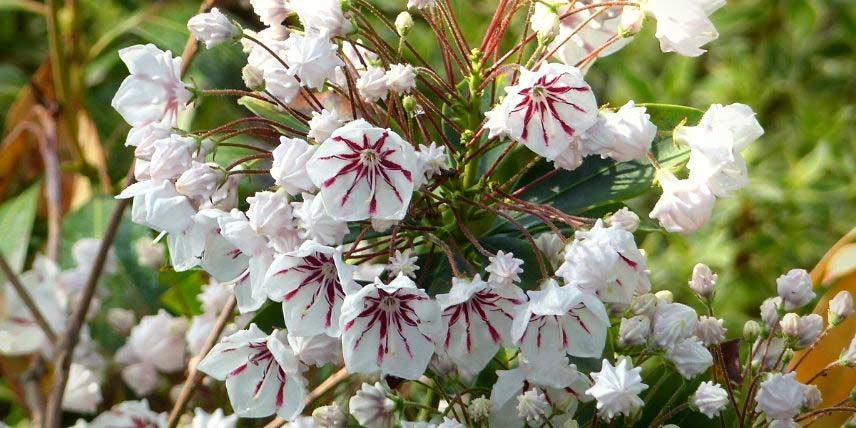
Kalmia latifolia ‘Peppermint’ bears superb white-pink flowers, maculate with dark red ray florets
- Subscribe!
- Contents



































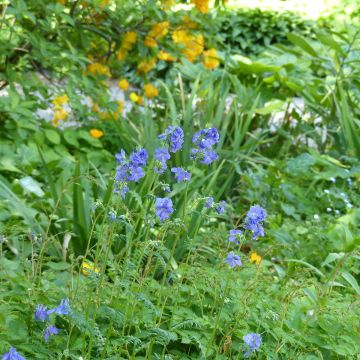
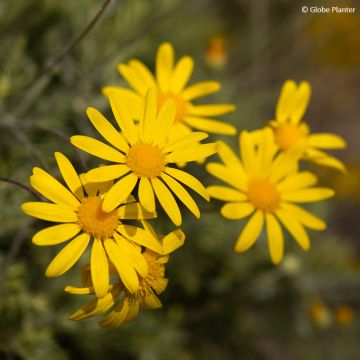
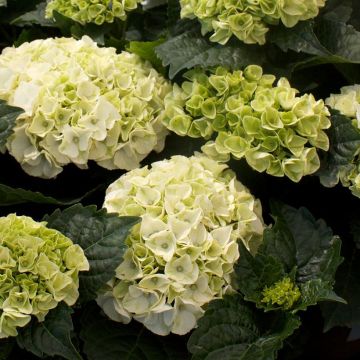
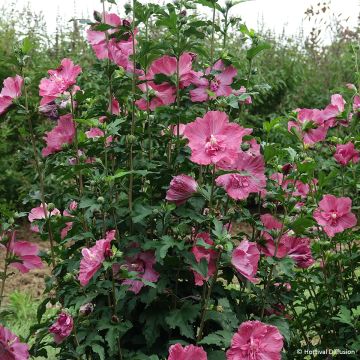



Comments